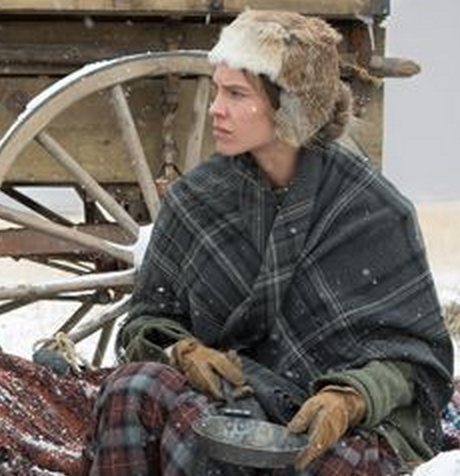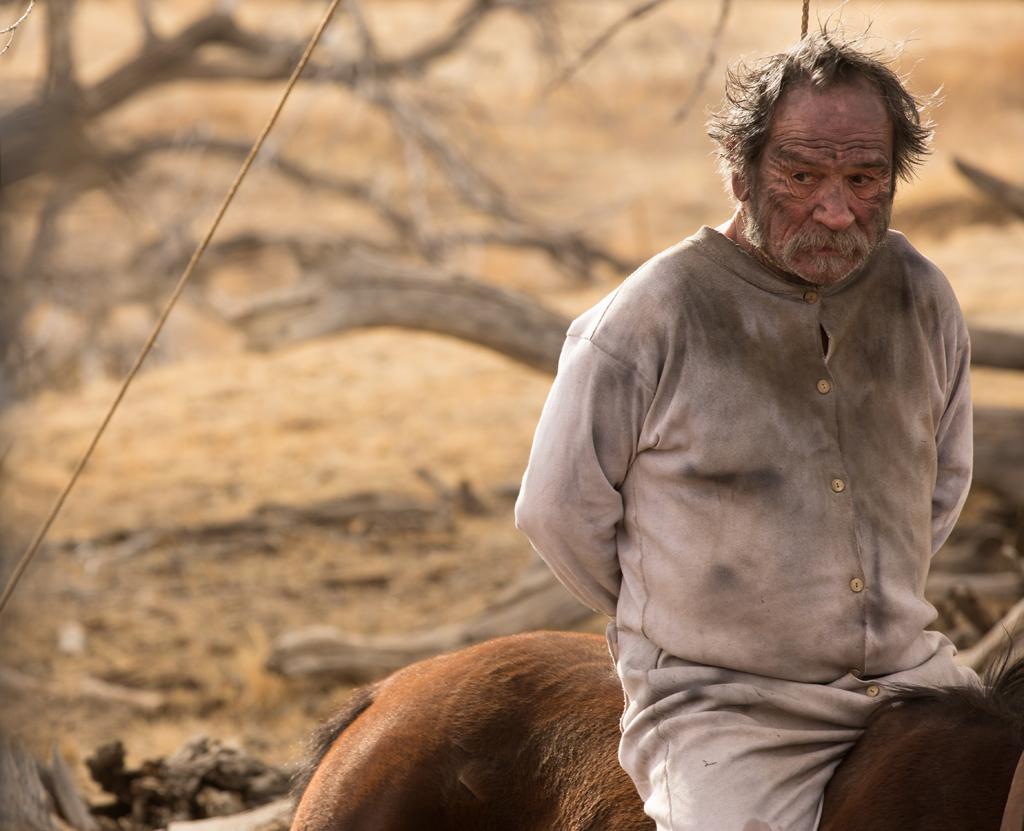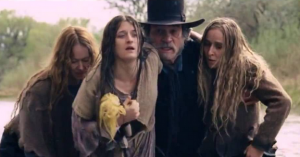 Too plain and too old by 1850s standards to be considered viable marriage material, ex-schoolteacher Mary Bee Cuddy (Hilary Swank) lives by herself in the Nebraska Territory. She tends to her livestock and her land by herself, literally and metaphorically wearing men’s trousers beneath her floor-length dresses. At night, she sings in her unfaltering high voice, accompanying herself silently on a cloth she has embroidered to resemble the piano she played daily when she still lived East. In “The Homesman,” it is a life of making-do.
Too plain and too old by 1850s standards to be considered viable marriage material, ex-schoolteacher Mary Bee Cuddy (Hilary Swank) lives by herself in the Nebraska Territory. She tends to her livestock and her land by herself, literally and metaphorically wearing men’s trousers beneath her floor-length dresses. At night, she sings in her unfaltering high voice, accompanying herself silently on a cloth she has embroidered to resemble the piano she played daily when she still lived East. In “The Homesman,” it is a life of making-do.
But other settlers in the still-mostly unpopulated region are having a more difficult time. The winter has been brutal, and not everyone has survived so far with their sanity intact. Arabella (Grace Gummer) has lost her children to diphtheria and becomes a silent, doll-clutching zombie; Theoline (Miranda Otto) has been so driven to despair that she threw her newborn baby down an outhouse hole; Gro (Sonja Richter) lost her mother in the snow and has since seemed demonically possessed. Unequipped for anything except basic survival, the men of the region determine these three must be sent back East. It falls upon Cuddy to shepherd them home in a locked box wagon and, upon rescuing loutish claim jumper George Briggs (Tommy Lee Jones) from a death by hanging, she forces him to accompany them on the trek. Despite her disapproval of him and her fierce independence, she accepts that she and the other women will not survive the journey by themselves. As it is, the journey through ice storms and hostile Indian territory proves untenable for some of them.
As sere and slow as the region it describes, “The Homesman” refuses to be a likeable film. Yet it is all the more compelling for its lack of accommodation, partly because of the unabashedly feminist perspective it takes on the pitfalls of Manifest Destiny and partly because of its fidelity to its source material, Glendon Swarthout’s eponymous, admirably spare 1988 novel. As the late author’s son Miles wrote in a new afterword to the book:
 History is always written by the Winners, in this case the largely white migration of Americans who journeyed west by horse and wagon with American military help, to subjugate the Indian tribe and cross the Rocky Mountains to the gold fields …. But Glendon was more interested in the Losers, the settlers who headed back east once more in much smaller caravans, destitute, their health and spirits broken. These pioneers have been denied their dreams of wealth and happiness in the Golden West and were now paying an awful price, fighting their way back east again. [My father] told these sad tales of the defeated citizens who quite often lost their minds trying to carve out a living on America’s wildest frontier.
History is always written by the Winners, in this case the largely white migration of Americans who journeyed west by horse and wagon with American military help, to subjugate the Indian tribe and cross the Rocky Mountains to the gold fields …. But Glendon was more interested in the Losers, the settlers who headed back east once more in much smaller caravans, destitute, their health and spirits broken. These pioneers have been denied their dreams of wealth and happiness in the Golden West and were now paying an awful price, fighting their way back east again. [My father] told these sad tales of the defeated citizens who quite often lost their minds trying to carve out a living on America’s wildest frontier.
Such sad tales are no more commonly told in Hollywood Westerns than they are in history books; their grind has little payoff since they rarely feature anything even as appealing as an antihero. “The Homesman” does not try to groom these underdogs into something less mangy. Instead, it succeeds by taking as many risks as its subjects do – shifting abruptly in tone from wryly comic (Briggs and Cuddy are an unlikely team) to tragic. A hairpin turn about eighty minutes into the film makes it clear just how few traditional comforts it is willing to provide us.
Tommy Lee Jones has played curmudgeons many times before and, although he does so especially well here, it is as director of this film that he has surpassed himself. With a painterly confidence, he captures the cold, dangerous seduction of the nineteenth-century American West – its vast skies, its uncluttered plains, its raging, lonely quiet. We surrender so completely to its uncompromising reign that when the travelers finally return East, the relative bustle – snugly built homes, delineated roads, and well-groomed men and women seemingly everywhere – seems stiflingly gentrified.
Swank soars when portraying characters facing impossible odds, and here she turns in her strongest performance since “Boys Don’t Cry.” Playing up her less traditionally feminine features – her square jaw, her heavy brow, her unwavering gaze – she is unadorned by anything but Cuddy’s powerful emotions. The woman’s resignation, kindness, and courage fill nearly every frame, and Jones ably creates that space. She may not blink when she is called “bossy” for acting in the best interest of herself and others (for acting, in many cases, as the men around her do) but we feel the sting of injustice. Jones ensures this is so.
 Ultimately, though, this is not even Cuddy’s tale. Nobody, this film suggests, can ever conquer their own nature – let alone the terrible, awesome nature of the West. Clear-eyed but never discompassionate, the journey film “The Homesman” collects uneasy truths that are all too often left by the wayside of our nation’s road to success.
Ultimately, though, this is not even Cuddy’s tale. Nobody, this film suggests, can ever conquer their own nature – let alone the terrible, awesome nature of the West. Clear-eyed but never discompassionate, the journey film “The Homesman” collects uneasy truths that are all too often left by the wayside of our nation’s road to success.
This review was originally published in Word and Film.
